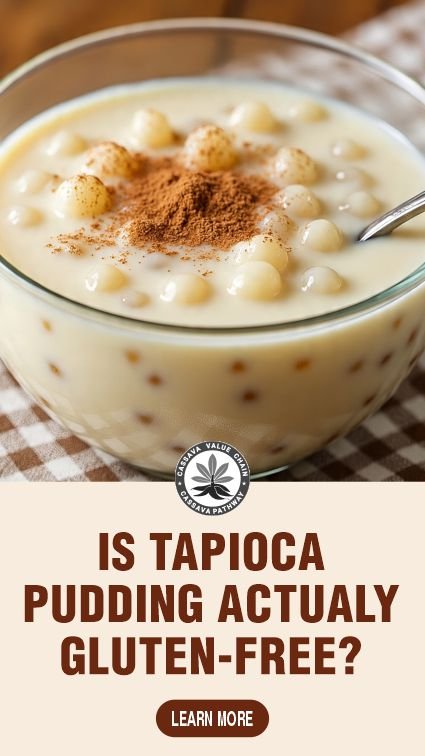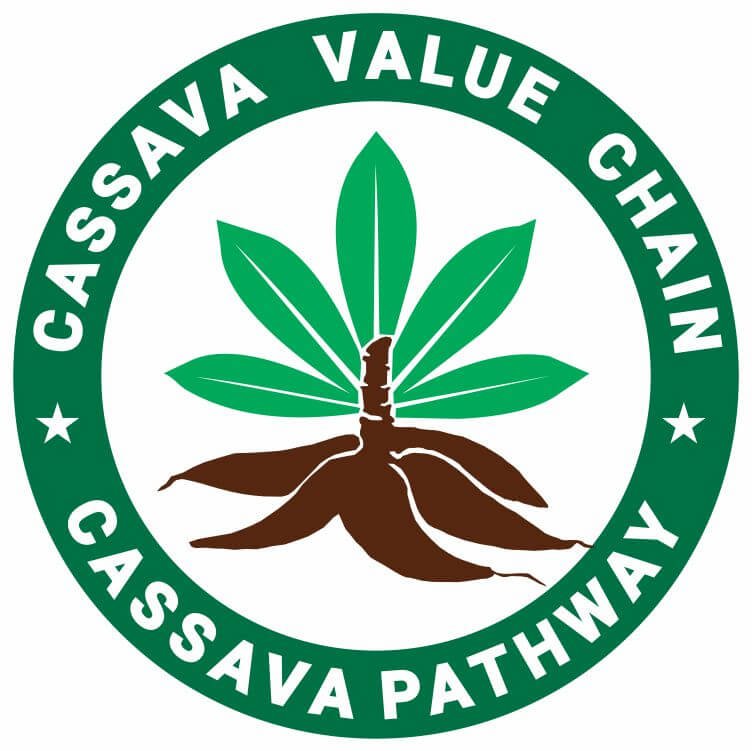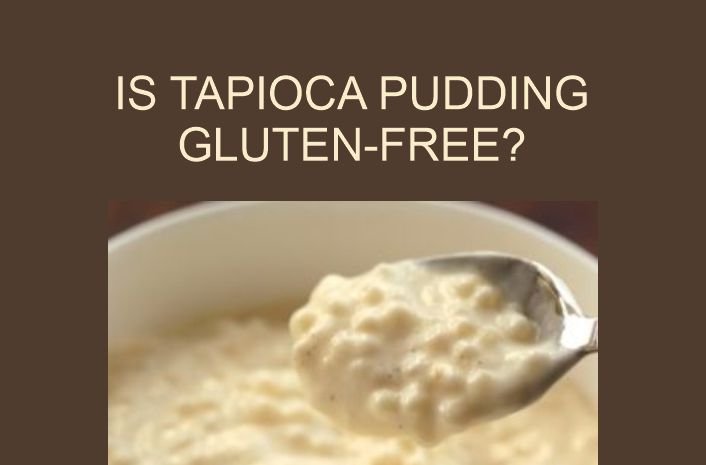Is tapioca pudding gluten-free? If you’re cutting out gluten, this creamy dessert might still be on the menu, but only if you know what ingredients to look out for.
If you’re searching for a dessert that fits your gluten-free needs, tapioca pudding may be one to consider.
Made from tapioca pearls sourced from the cassava plant, this creamy dish is naturally free of wheat and other common gluten-containing grains.
As more people shift toward gluten-free eating due to celiac disease or gluten sensitivity, questions around everyday treats like tapioca pudding continue to grow.
Its short ingredient list, typically just tapioca pearls, milk, sugar, and flavorings, makes it seem like a safe option.
But if you’re dealing with gluten intolerance or preparing food for someone who is, you’ll need more than assumptions.
This guide breaks down what you should know about gluten in tapioca pudding, clears up confusion, and helps you enjoy this dessert without second-guessing your choices.
Table of Contents
- What Makes a Dessert Gluten-Free?
- Tapioca Starch and Gluten: The Core Ingredient
- Does Traditional Tapioca Pudding Contain Gluten?
- How to Make Sure Your Tapioca Pudding Is Gluten Free
- Best Gluten-Free Tapioca Pudding Recipe Variations
- Common Misconceptions About Gluten-Free Desserts
- Hidden Sources of Gluten in Desserts
- Tips for a Successful Gluten-Free Dessert Experience
- Conclusion
What Makes a Dessert Gluten-Free?
A dessert is gluten-free when it contains no ingredients made from gluten-containing grains such as wheat, barley, or rye.
Gluten is a protein that gives dough its elasticity; however, for people with celiac disease or gluten intolerance, it triggers digestive and immune reactions.
To make a dessert gluten-free, bakers replace regular flour with alternatives like rice flour, almond flour, coconut flour, cassava flour, or cornstarch.
Certified gluten-free products are produced in facilities that prevent cross-contamination, ensuring the food remains safe to eat.
Checking labels for “gluten-free” certification and avoiding additives made from malt, modified starch, or wheat derivatives is essential.
A truly gluten-free dessert must use safe ingredients, clean preparation tools, and verified manufacturing practices, offering the same sweetness and texture without the health risks associated with gluten.
Related Posts
How Healthy Is Tapioca Pudding?
How Good is Tapioca Pudding for You?
What Diabetics Should Know about Tapioca Pudding
Why Mango Tapioca Pudding is a Summer Favorite
Mistakes to Avoid When Making Chocolate Tapioca Pudding

Tapioca Starch and Gluten: The Core Ingredient
Tapioca starch gives tapioca pudding its smooth, creamy texture and mild sweetness. If you’re avoiding gluten, this ingredient works perfectly for you.
Tapioca comes from the cassava root, a naturally gluten-free plant that’s safe for people with celiac disease or gluten sensitivity.
It’s a great alternative to wheat-based thickeners and flours.
But since some facilities process both gluten and gluten-free products, cross-contamination can happen.
Always check for a gluten-free certification label before buying tapioca starch or pudding mix.
This label confirms the product meets strict standards and remains safe for your diet.
Choosing certified tapioca lets you enjoy your dessert with peace of mind, knowing it’s free from gluten and processed with care. It’s a simple way to enjoy pudding that fits your gluten-free lifestyle.
Does Traditional Tapioca Pudding Contain Gluten?
Traditional tapioca pudding is naturally gluten-free when made with basic ingredients like tapioca pearls, milk, sugar, and eggs.
Tapioca pearls come from the cassava root, which contains no gluten, making the pudding safe for people with celiac disease or gluten sensitivity.
However, packaged or commercially made versions may include additives such as thickeners, stabilizers, or flavorings that can contain gluten or be processed in facilities handling gluten products.
Modified food starch, for example, can sometimes come from wheat.
To stay safe, always check for gluten-free certification on the label or make your own tapioca pudding at home.
Preparing it yourself ensures control over ingredients and prevents cross-contamination.
In its pure form, traditional tapioca pudding offers a creamy, satisfying dessert that fits perfectly into a gluten-free diet.
How to Make Sure Your Tapioca Pudding Is Gluten Free
If you love tapioca pudding and follow a gluten-free diet, you need to pay attention to how it’s made.
A few careful steps can keep your dessert completely safe to enjoy.
Read the Labels Before Buying
Before picking any pre-made tapioca pudding, check the label carefully.
Look for clear “gluten-free” certification and scan the ingredient list for hidden sources of gluten.
Some thickeners or flavoring agents may contain wheat or barley.
Choosing trusted brands that test their products helps you stay worry-free.
Ask Questions When Eating Out
If you’re at a restaurant or bakery, ask how their pudding is prepared.
Find out if it’s made on-site and if the kitchen prevents gluten cross-contamination.
Restaurants that care about gluten-free diets will understand your needs and provide honest answers about their ingredients and processes.
Use Certified Gluten Free Tapioca Pearls
When making tapioca pudding at home, choose certified gluten-free tapioca pearls.
These are produced in dedicated facilities that limit gluten exposure.
You can find them in health food stores or online.
Making pudding from scratch gives you control over every ingredient and keeps your dessert completely gluten-free.
Check Toppings and Add-Ins
Extra toppings like fruits, sauces, or syrups can make your pudding tastier, but always confirm they are gluten-free.
Read labels and avoid items made with malt or wheat starch.
With clean ingredients and mindful preparation, you can enjoy creamy tapioca pudding without risking gluten exposure.
Best Gluten-Free Tapioca Pudding Recipe Variations
Tapioca pudding gives you a creamy base that easily fits a gluten-free diet.
You can customize it to suit your taste using simple ingredients that keep it safe and satisfying.
Coconut Milk Tapioca Pudding
If you love a creamy and rich dessert, coconut milk tapioca pudding is a perfect choice.
Replace regular milk with full-fat coconut milk to give your pudding a smooth, velvety texture and a naturally sweet taste.
Coconut milk pairs beautifully with the chewiness of tapioca pearls, creating a satisfying treat that feels tropical and comforting.
You can serve it warm or chilled, depending on your preference.
For extra flavor, top it with toasted coconut flakes, sliced banana, or a drizzle of maple syrup.
Every spoonful delivers a gentle sweetness and soothing creaminess that fits perfectly into a gluten-free lifestyle.
Vanilla Tapioca Pudding
Vanilla tapioca pudding brings a classic, timeless flavor that never goes out of style.
Add a teaspoon of pure vanilla extract or fresh vanilla bean seeds to your pudding mixture for a fragrant and inviting aroma.
The subtle warmth of vanilla deepens the natural sweetness of tapioca, turning a simple dessert into something special.
This variation works well with both dairy and plant-based milk options, so you can adapt it to your dietary needs.
For a finishing touch, garnish with a sprinkle of cinnamon or a few fresh berries.
It’s a gluten-free dessert that feels both nostalgic and comforting.
Chocolate Tapioca Pudding
For a rich, satisfying twist, try chocolate tapioca pudding.
Add unsweetened cocoa powder or melted dark chocolate to your pudding mixture to create a deep, chocolatey flavor that blends perfectly with tapioca’s creamy base.
This version feels indulgent yet remains gluten-free and wholesome.
You can use coconut milk or almond milk for extra smoothness and a slightly nutty taste.
Serve it chilled and top it with sliced strawberries, shaved dark chocolate, or a dollop of whipped cream for a beautiful finish.
It’s an easy way to turn a simple pudding into a decadent gluten-free dessert you’ll crave again.
Spiced Tapioca Pudding
If you enjoy warm, comforting desserts, spiced tapioca pudding is a wonderful option.
Add a pinch of cinnamon, nutmeg, or cardamom while cooking to give your pudding a cozy aroma and a flavorful depth.
The spices balance perfectly with tapioca’s natural sweetness and work well with coconut or almond milk.
You can also include a drop of vanilla for an added layer of warmth.
Serve it warm during cooler months or chilled with a dusting of cinnamon on top.
Each bite brings gentle spice and smooth texture, making this variation both relaxing and gluten-free.
Fruity Tapioca Pudding
Fruity tapioca pudding brings freshness and color to your dessert bowl.
Mix in diced mango, pineapple, strawberries, or blueberries for a naturally sweet flavor that complements the pudding’s creamy base.
The fruit adds texture and a light, refreshing taste that balances the richness of the tapioca.
For extra crunch, top it with chopped almonds, chia seeds, or pumpkin seeds.
You can even use fruit purees as a swirl for added flavor and visual appeal.
This gluten-free variation makes a great summer dessert or light breakfast option that keeps you feeling satisfied without feeling heavy.
Common Misconceptions About Gluten-Free Desserts
Gluten-free desserts have become popular as more people adopt gluten-free diets.
Yet, some myths about them still cause confusion and poor food choices.
Let’s clear them up.
Gluten Free Does Not Always Mean Healthy
You might assume gluten-free desserts are automatically good for you, but that’s not always true.
Removing gluten doesn’t remove sugar, fat, or artificial ingredients.
Some gluten-free treats can be just as calorie-dense as traditional ones.
Always read the nutrition label to understand what you’re eating.
Choose desserts made with whole ingredients like fruits, nuts, and natural sweeteners for a better balance.
Gluten-free should fit into your healthy eating plan, not replace it.
Not All Gluten-Free Desserts Are the Same
A gluten-free label doesn’t guarantee that every ingredient in a dessert is safe for people avoiding gluten.
Tapioca pudding, for example, is naturally gluten-free because tapioca comes from cassava, but added flavorings or thickeners can contain gluten.
Some products may also be processed in facilities that handle wheat or barley.
To stay safe, look for certified gluten-free products and research the brands you buy.
Gluten Free Does Not Mean Guilt Free
It’s easy to believe that gluten-free desserts are lighter or better for weight management, but they can still be packed with sugar and fats.
The gluten-free label only means it lacks gluten, not that it’s low-calorie or nutrient-rich.
When you treat yourself, do it mindfully. Enjoy moderate portions and balance them with wholesome meals throughout the day.
Gluten-free desserts should bring pleasure, not guilt or excess.
Labels Are Your Best Guide
The only way to know if a dessert truly fits your gluten-free diet is by reading the label.
Check for gluten-free certification and scan the ingredient list for hidden gluten sources like malt or modified starch.
If you’re unsure about a product, contact the manufacturer or prepare desserts at home with trusted ingredients.
Staying informed helps you enjoy gluten-free desserts with confidence and peace of mind.
Hidden Sources of Gluten in Desserts
You might think your dessert is gluten-free, but gluten hides in places you least expect. Knowing where it lurks helps you make safer, smarter choices when satisfying your sweet tooth.
Baking Mixes and Pre-Packaged Ingredients
Cake mixes, pudding powders, and dessert toppings can contain wheat flour or gluten-based stabilizers. Always check ingredient labels carefully. Even a small amount of gluten can cause a reaction if you have celiac disease or sensitivity.
Malt Extract and Chocolate Flavorings
Some chocolate syrups, candies, and sweet coatings use malt extract made from barley. This sneaky ingredient adds flavor but brings gluten along. Choose desserts labeled gluten-free to stay safe.
Cross-Contamination in Production
Desserts processed in shared facilities can pick up traces of gluten from equipment or packaging surfaces. Look for certified gluten-free labels to avoid hidden gluten exposure.
Hidden Gluten in Additives
Soy sauce, spice blends, and flavored extracts sometimes contain gluten used in manufacturing. Read product details carefully and opt for certified gluten-free alternatives when baking or buying desserts.
Safe Gluten-Free Alternatives
Use natural binders like tapioca starch, cornstarch, or rice flour when preparing gluten-free desserts. These options provide structure and smooth texture without the risks of gluten contamination.
Tips for a Successful Gluten-Free Dessert Experience
Creating gluten-free desserts can be enjoyable when you follow the right steps.
Always communicate your dietary needs clearly when eating out or ordering desserts.
Ask about ingredients and preparation to prevent cross-contamination.
When shopping, check for certified gluten-free labels instead of relying only on “gluten-free” tags, as some products may still be exposed to gluten.
At home, prepare your baking area by separating utensils, cutting boards, and bowls used for gluten-free recipes.
Organizing your workspace reduces the risk of contamination.
Use reliable gluten-free flours and starches for consistent results.
You can also find creative ideas through gluten-free cookbooks, online resources, or supportive baking communities.
With careful planning and awareness, you’ll enjoy gluten-free desserts that are both safe and satisfying.
Conclusion
Tapioca pudding is naturally gluten-free since its main ingredient, tapioca starch, comes from cassava root and contains no gluten.
It’s a safe dessert choice for people with gluten intolerance or celiac disease when prepared carefully. However, some store-bought versions may include additives or flavorings tha
t introduce gluten, so always read labels and choose certified gluten-free products.
Making tapioca pudding at home allows better control over ingredients and flavors.
You can add fruits, spices, or dairy alternatives to suit your taste and dietary needs.
With mindful preparation and ingredient awareness, tapioca pudding remains a delicious gluten-free dessert that combines comfort, flavor, and peace of mind.s and safe dessert choice worthy of exploration.
References

Chimeremeze Emeh is a writer and researcher passionate about Africa’s most transformative root crop—cassava. Through his work at cassavavaluechain.com, he explores the entire cassava industry, from cultivation and processing to its diverse applications in food, health, and industrial use.
He also writes for palmoilpalm.com, where he shares his extensive experience and deep-rooted knowledge of palm oil, covering red palm oil, palm kernel oil, and refined products. His work there reflects his lifelong connection to agriculture and his commitment to promoting sustainable value chains in Africa.
Driven by curiosity and purpose, Chimeremeze aims to shed light on how cassava continues to empower communities, strengthen food systems, and link traditional farming wisdom with modern innovation.

